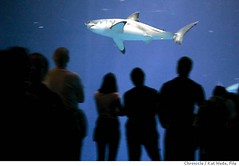April 1, 2005

And how is the little darling do? Splendidly, apparently. It was last recorded off the coast of Santa Barbara. The electronic tag placed on the shark by aquarium officials, broke off and popped to the surface as it was programmed to do, 25 miles west of Point Conception. That's far enough away from Monterey Bay to tell scientists she is doing well. The tag is still floating in the water, sending readings on what temperatures and depths she liked, which would give them the best data ever on what great whites do in the wild when they are not noshing on surfers.
[By the way, one of the stories on the shark was written for the local Santa Cruz Sentinel by a reporter named Brian Seals. No wonder he got the assignment. ]
No comments:
Post a Comment